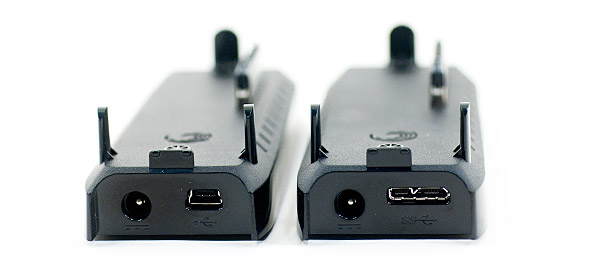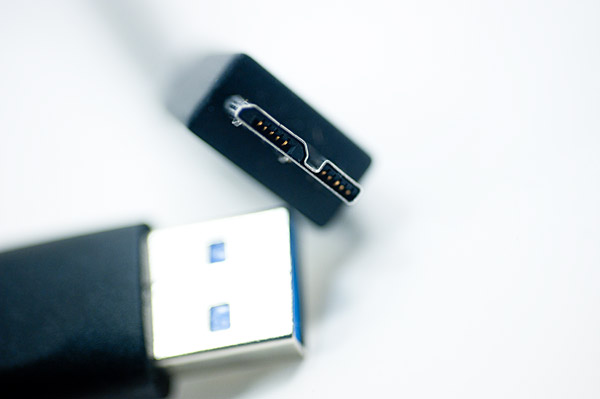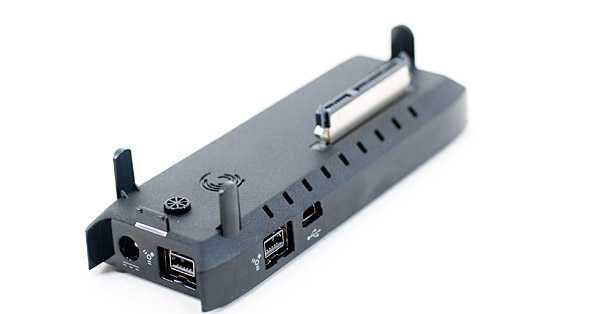The World's First 3TB HDD: Seagate GoFlex Desk 3TB Review
by Anand Lal Shimpi on August 23, 2010 12:39 AM EST- Posted in
- Storage
- Seagate
- HDDs
- GoFlex Desk
USB 2.0, 3.0 and FireWire 800 Performance
Seagate sent all three docks for review and I benchmarked the 3TB GoFlex Desk under both Windows 7 and Mac OS X 10.6.4 to get an idea for its performance. The full results are below, but I’ll give you the gist of it here.

USB 2.0 and USB 3.0 docks (left and right)
Over USB 2.0 I got around 30MB/s for sequential reads/writes. That’s 240Mbps, about half of the USB 2.0 spec maximum.
| Windows Performance Comparison | |||||
| Seagate GoFlex Desk 3TB (USB 2.0) | Seagate GoFlex Desk 3TB (USB 3.0) | ||||
| Sequential Read | 33.1 MB/s | 151.9 MB/s | |||
| Sequential Write | 26.9 MB/s | 151.2 MB/s | |||
| Random Read | 0.30 MB/s | 0.30 MB/s | |||
| Random Write | 0.93 MB/s | 0.93 MB/s | |||
USB 3.0 performance is just awesome, the drive performs just like an internal hard drive. It's a shame that USB 3.0 isn't more ubiquitous because this is great performance not to mention that you get backwards compatibility with USB 2.0 systems. The only issue is you need to make sure you don't lose the USB 3.0 cable since the drive-end of it is not backwards compatible.
I actually got better performance over USB 3.0 than I did with the drive connected via SATA at around 150MB/s for sequential reads/writes. The SATA to USB 3.0 bridge does some additional buffering that may be the cause of the improved performance here. Random performance remained unchanged regardless of what interface I used.

The USB 3.0 cable that ships with the GoFlex Desk USB 3.0 dock. It works in both USB 2.0 and USB 3.0 ports.
On the Mac, without Iometer I had to resort to XBench for the performance numbers. All of these are written via the filesystem but are uncached:
| Mac Performance Comparison - XBench 1.3 | |||||
| Seagate GoFlex Desk 3TB (USB 2.0) | Seagate GoFlex Desk 3TB (FireWire 800) | ||||
| Sequential Read | 17.0 MB/s | 74.9 MB/s | |||
| Sequential Write | 15.8 MB/s | 47.6 MB/s | |||
| Random Read | 0.68 MB/s | 0.73 MB/s | |||
| Random Write | 1.80 MB/s | 1.78 MB/s | |||
USB 2.0 performance was aroun 15 - 17MB/s while FireWire 800 managed 47.6MB/s for sequential writes and 75MB/s for sequential reads. Copying files to the drive manually I saw very similar numbers over FireWire 800 (53MB/s writes, 78MB/s reads). Note that performance was identical regardless of whether I was using Paragon’s NTFS driver or I formatted the drive in OS X’s native HFS+ file format.

FireWire 800
What this tells us is that, at least compared to FireWire 800 on a Mac Pro, the USB 3 connection in Windows is still the quickest way to write to the drive. There is one more stipulation that I must bring up. Most mainstream motherboards with an Intel chipset don’t give USB 3 controllers enough bandwidth to deliver these sorts of results. I was using a Gigabyte X58A-UD5, but many other boards dangle the USB 3 controller off of a single PCIe x1 lane running at 250MB/s (250MB/s each direction). In these cases you’ll still get better than USB 2.0 performance but you may not see the same numbers I got here.
I wrote about this issue while talking about 6Gbps SATA controllers on Intel motherboards here, but the same problem documented in that article applies to USB 3.0.










81 Comments
View All Comments
Belard - Monday, August 23, 2010 - link
ALL brands have their bad batches. Maxtor, WD, Hitachi-IBM, etc... and even intel.I have used lots of Seagates and Maxtors with good reliability. Yes, I've had failures - but not really any more than WD.
In the OLD days, Seagates were called "Sea-crates" typically used in cheap PCs ($2000+ computers) - I'd never touch those junky RLL drives. I bought Quantum SCSI drives which were higher end, more reliable and costs more money... and being SCSI - they were much faster. I miss Quantum. :( Today, I buy Seagates - they are easily quieter than most drives - with only Samsung just as quiet.
I still buy 1TB Seagates. I don't trust the 1.5~2TB drives from anyone. But the tech used in 2~3TB drives are filtered down to the 500GB drives (single 500GB platter) - so the density reliability issue is there - but the less-parts (heads and arms) factor does help. So todays 500GB drives are very thin... wow! ;)
mewgirl - Monday, January 31, 2011 - link
....But since WD is THE WORST manufacturer of external hard drives, this post means you are definitely NOT recommending Seagate, then, correct?mino - Monday, August 23, 2010 - link
You should NEVER use an on-demand cooling system with magnetic storage.Hard disks are an order of magnitude more sensitive to temperature changes than pure high temperatures.
Jonathan Dum - Monday, August 23, 2010 - link
Interesting. Proof to back up that claim?has407 - Monday, August 23, 2010 - link
The OP is nominally correct. While I wouldn't go so far as to say "NEVER use an on-demand cooling system", I'd say they're likely to do more harm than good unless carefully engineered and integrated with the HDD.Rapid changes in temperature can kill a drive faster than elevated temps due to, e.g., thermal expansion/contraction of components (heads, platters, spindles, etc.), and air density changes which affect head ride height.
Those changes require active adjustment and compensation, and are necessary and common in today's drives/controllers. However, there are limits. Drive manufacturers specify a maximum temp change/time (even if it may not show in the data sheets available on their web site).
The best solution is to maintain a steady and moderate temperature change. The worst solution is a typical/cheap "bang-bang" controller that starts/stops when temperature limts are reached, and which causes rapid changes in the drive's temperature.
Case in point: The absolute worst thing you can do for your laptop drive after leaving it in the car for hours on a frigid day is drag it into a warm room and immediately start pounding on it. Virtually guaranteed to result in errors and reduced life (if not short-term failure).*
In short, active cooling is not necessarily bad, but stupid active cooling that causes wide temp swings over short periods in the drive can cause far worse problems than allowing the drive to run at an elevated and slowly changing temp.
This has been a problem for many years, and increasingly as tolerances decrease (especially with higher track densities). While drives/controllers continue to adapt and improve, it's still a significant factor, and the larger the media the worse the problem. For recent papers (sorry, don't have any recent freely available links), see:
http://scitation.aip.org/getabs/servlet/GetabsServ...
http://ieeexplore.ieee.org/Xplore/login.jsp?url=ht...
* Yes, people talk about the "freeze your HDD" to try and recover it. (It may even work--never tried it.) But subjecting an HDD to that kind of rapid temperature change abuse even occassionally is guaranteed to kill it in short order.
JonnyDough - Monday, August 23, 2010 - link
It makes a lot of sense, even without the links. The hardest thing on a car is starting it in the dead of winter when there's no oil up in the engine. It grinds, and then as the friction causes it heat up quickly with cold oil it continues grinding until it is warm and coated in oil internally.mindless1 - Monday, August 23, 2010 - link
That is wrong. If you have a constant speed/always-on cooling system, it means that the drive changes in temperature as it wakes up, reads and writes, and more as it keeps running.If you have on-demand, as the drive starts to warm the fan kicks in and keeps the drive at a more constant temperature, including increasing fan RPM as needed to keep the drive at the same temperature! Plus, with on-demand all those times you are not using the drive and it is sleeping and at low temperature, your fan isn't pulling in dust to clog up things.
Also, it IS high temperature that does damage. Granted, yes it has to change temperature to get to a high temp, but the more the temperature changes the more the different coefficients of expansion come into play. For example, you can stretch a rubber band all day long, but if you stretch it too far it starts to rip apart.
Belard - Monday, August 23, 2010 - link
This or anyone else... should have minded the heat problems. There are external cases for HDs that have an 80mm cooling fan - low RPM.My Seagate drives in my case (1TB) are currently 39c... I run my fan at LOW speed to keep the noise to pretty much silent. A drive hitting 50c+ would make me nervous... 60+ is VERY bad!
And for a 3TB drive holding that much data, RELIABILITY is most important! USB 3.0 and such are important features when moving that much data and it'll slow down when you're using the drive for what it is intended?!
BAD BAD BAD
The dock is a handy, but a wider one would be nicer... there are other dock-drive designs out there, some with dual docks. Generic versions that allows you to put in ANY drive would be the way to go. OR better yet... use the HOT-SWAP abilities of eSATA and pop your drive into a drive bay on your computer - NO DOCK NEEDED!
Theres about 60+ options on Newegg. Many docks, you just plug in your drive - sans case.
Aikouka - Monday, August 23, 2010 - link
Heat problems are one of the reasons why I'm starting to shy away from Seagate drives after using them for a few years. A few months ago, I noticed that one of my WD 1TB HDDs was exhibiting some odd file read issues. When I opened up my server, I found it right above a Seagate 1TB HDD, and when I tried to pull the Seagate drive out, it was almost too hot to touch!Of course a (mechanical) hard drive will produce heat, but the Seagate seemed to be in a league of its own compared to all the other drives in my file server. I'm really not sure what brand to even go with now... I purchased a Samsung drive based on recommendations, and that drive died after only two months (the whole random disappearing act leading to refusing to ever show up). I recently purchased a WD 2TB drive that came up clean in a full-disk error check, so we'll see how that goes!
mindless1 - Monday, August 23, 2010 - link
Your server is not set up correctly, blame it not the drive. A proper case configuration for stacked drives leaves at least 1cm or so between each and ample cool intake airflow through the drive rack. In that scenario you will have no problem cooling any 7200 RPM drive, or with higher airflow rate, 10K RPM drives too.Also, there is not a significant difference in operating power or running temp of equivalent drives from Seagate vs other brands. Single-digit # of degrees is not enough to matter one way or the other till you reach the upper limits.